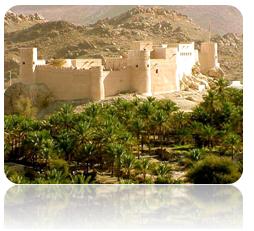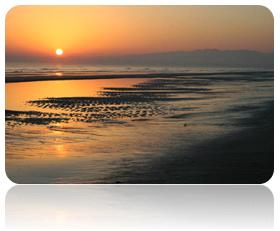Is Oman the new Dubai? The sultanese has certainly been making moves in that direction over the past few years it has an added edge. Where Dubai and Abu Dabi are merely cities, Oman is a fasinating blend of coastal and desert landscape with colonial Portugese influences and stunning natural wonders. Forts and Castles are Oman's most striking cultural landmarks and, together with its towers and city walls, they have historically been used as defensive bastions or look-out points. Forts were often the seats of administrative and judicial authority. There are over 500 forts, castles and towers in Oman which has a coastline of 1,700 kms, so they were needed to protect it from potential invaders. The architectural styles vary, being determined by the architects who built them or the periods in which they were built.
Here are some sights to make sure you take in while you're there.
Jalali and Mirani
Oman's most famous forts stand at the entrance to Muscat bay. Mirani, which was built before the arrival of the Portuguese, was originally shaped like a tower. Then in 1588 the Portuguese rebuilt it on the ruins of its old structure, adding emplacements, stores, living quarters for the commander and a place of worship. The Portuguese completed their construction of Jalali Fort in 1587. Its present-day form dates from the reign of Sayyid Said bin Sultan, and this Fort was later restored and converted into a museum.
Muscat
Muscat, even to this day, has a character quite different from neighbouring capitals. There are few high-rise blocks, and even the most functional building is required to reflect tradition with a dome or an arabesque window. The result of these strict building policies is an attractive, spotlessly clean and whimsically uniform city – not much different in essence from the ‘very elegant town with very fine houses’ that the Portuguese admiral Alfonso de Alburqueque observed as he sailed towards Muscat in the 16th century.
Sharqiya (Wahiba) Sands
A destination in their own right, or a diversion between Muscat and Sur, these beautiful dunes, formerly known as Wahiba Sands, could keep the visitor occupied for days. Home to the Bedu (Bedouin), the sands offer the visitor a glimpse of a traditional way of life that is fast disappearing as modern conveniences limit the need for a nomadic existence.
Sohar
Remember Sinbad the sailor? Perhaps you didn't realise he was based on a real life sailor and it's even less likely that most people know this was where that that character lived. Sohar is one of those places where history casts a shadow over modern reality. As early as the 3rd century BC, the town’s prosperity was built on copper that was mined locally and then shipped to Mesopotamia and Dilmun (modern-day Bahrain).
Here are some sights to make sure you take in while you're there.
Jalali and Mirani
Oman's most famous forts stand at the entrance to Muscat bay. Mirani, which was built before the arrival of the Portuguese, was originally shaped like a tower. Then in 1588 the Portuguese rebuilt it on the ruins of its old structure, adding emplacements, stores, living quarters for the commander and a place of worship. The Portuguese completed their construction of Jalali Fort in 1587. Its present-day form dates from the reign of Sayyid Said bin Sultan, and this Fort was later restored and converted into a museum.
Muscat
Muscat, even to this day, has a character quite different from neighbouring capitals. There are few high-rise blocks, and even the most functional building is required to reflect tradition with a dome or an arabesque window. The result of these strict building policies is an attractive, spotlessly clean and whimsically uniform city – not much different in essence from the ‘very elegant town with very fine houses’ that the Portuguese admiral Alfonso de Alburqueque observed as he sailed towards Muscat in the 16th century.
Sharqiya (Wahiba) Sands
A destination in their own right, or a diversion between Muscat and Sur, these beautiful dunes, formerly known as Wahiba Sands, could keep the visitor occupied for days. Home to the Bedu (Bedouin), the sands offer the visitor a glimpse of a traditional way of life that is fast disappearing as modern conveniences limit the need for a nomadic existence.
Sohar
Remember Sinbad the sailor? Perhaps you didn't realise he was based on a real life sailor and it's even less likely that most people know this was where that that character lived. Sohar is one of those places where history casts a shadow over modern reality. As early as the 3rd century BC, the town’s prosperity was built on copper that was mined locally and then shipped to Mesopotamia and Dilmun (modern-day Bahrain).

Oman


For more information visit www.omantourism.gov.om
Search and book flights to Oman here
Search and book flights to Oman here